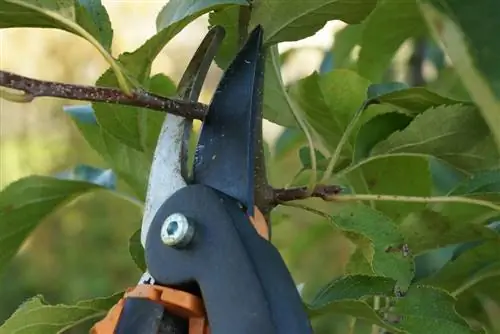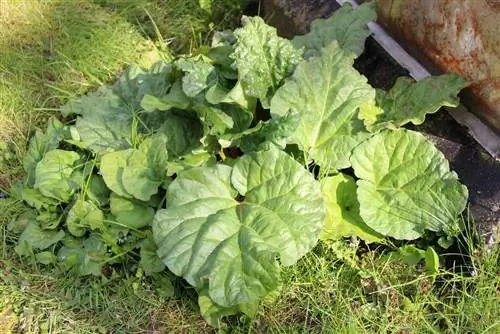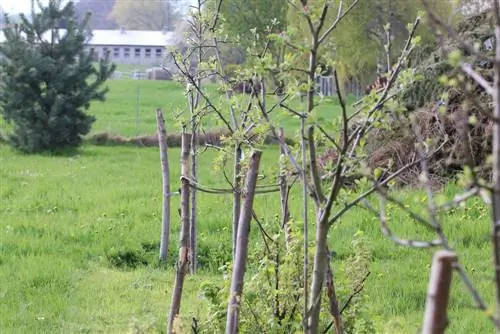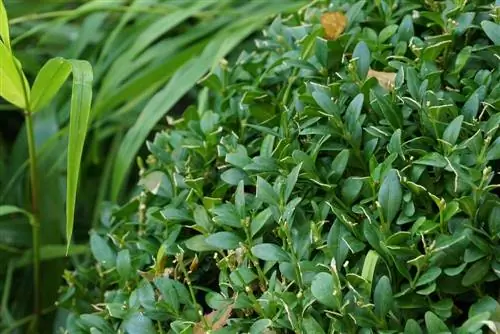- Author admin [email protected].
- Public 2023-12-17 03:39.
- Last modified 2025-01-24 12:45.
Pruning the boxwood is basically simple: do the basic pruning in the spring and, if necessary, prune again over the course of the season. As soon as the green forest of leaves is to be formed into a figure, you need proper instructions, which are not particularly complicated for simpler figures. Just the execution can take a lot of time depending on the desired level of precision, and the best cutting times become a little more important:
Profile
- The genus Buxus belongs to the boxwood family in the order Boxelaceae
- This genus of box trees has around 100 species, but is otherwise pretty much alone in the plant world
- Of the 100 species, only one can withstand the German climate: the Buxus sempervirens, the common boxwood
- We only prune one botanical type of boxwood, no matter how different the individual plant may appear
- The differences were worked out over a long period of boxwood breeding
- They affect the size of the leaves, the number of shoots and the density of growth
- These differences mainly affect the topiary, the smaller and denser the leaves, the more precise the shape
- Which then means: cut more often and more precisely
- The genetic characteristics, which are not influenced by breeding, are the same in all of our box trees
- What does e.g. mean for trimming? B. the timing requirements apply to all box trees growing in our area
- Box trees of different shapes also behave in the same way when it comes to trimming old (previous year's) wood
Tip:
The more a boxwood needs to be shaped, the more precisely you have to imagine the later effect on the planned location before planting. Narrow columnar shapes visually make the garden smaller, when planted in a row they provide a direction (walking or viewing) or act as a green wall to delimit a specific garden space. You can also create boundaries with low boxwood hedges, which do not obstruct the view and therefore have a different effect. With a beautiful boxwood figure, it is important that it can be clearly seen where it is placed (if it is to be large, it should be possible to view it from at least one line of sight at a distance).
Cut boxwood correctly
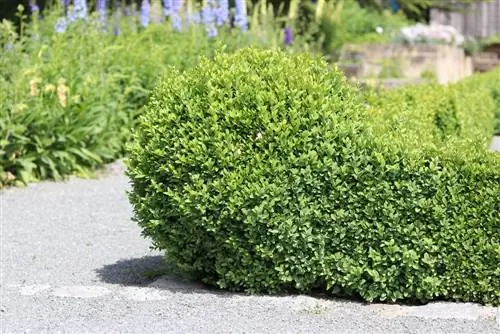
As was just explained in the profile, all German boxwoods need/get exactly the same basic cut. Only when it comes to topiary do differences between the individual cultivars come into play. Whether and how you prune your boxwood correctly depends a little on your expectations of the result. This applies to each of the following “cut levels”:
Loose boxwood cut
Pruning a boxwood tree that grows as a shrub at the garden gate, delimits planted areas along the path as a border without any special cutting shape or offers a little inconspicuous privacy in a group is simple and requires little work:
- Before budding begins, the boxwood gets its basic cut
- Initially, this cut determines the rough shape
- Later basic cutting means shape correction if parts of the Buxus go astray
- Only the basic cut may go into the old wood
- The boxwood is still in the dormant phase at the time of cutting
- Injuries to the old wood (from the previous year) also heal without the Buxus losing too much sap
- With basic pruning, free to loosely growing boxwoods can be shortened a little all around if necessary
- Need is e.g. B. if you want the boxwood to branch out more
- Or if it should be slowed down in height/width growth
- After sprouting, damaged branches can be removed until around September
- Every cut should now be limited to new growth
- Old wood now has so much to do with wound healing that it often no longer sprouts
Straight cuts of boxwood hedges
The “next cutting level” concerns e.g. B. the box trees, which are square, practical and well encircling the herb garden, but also the large hedge around the property, regardless of whether it is round, oval or square at the top.
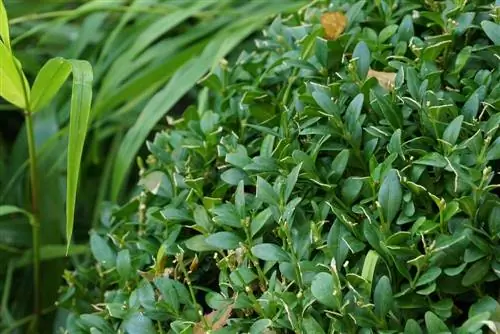
These boxwood row plantings, grouped into units, are pruned in exactly the same way as a solitary topiary, but it is not necessary to proceed as precisely as with strict topiary:
- The rough shape is done as just described
- The fine pruning work on the straight surfaces is started when the shoots have grown a few centimeters
- It's usually around mid-May
- But they are generally possible throughout the entire season, until the end of August/beginning of September
- If you don't want the hedge to get any taller, the new growth has to give way except for a remaining piece
- But the same applies here: Don't cut into the old wood because it won't heal well anymore
- If the plant is still to grow, only a piece of the new growth is sacrificed
- A little pruning is also advisable in this case so that the boxwood branches further
How exactly you prune here depends on your personal need for perfection: For some gardeners, the barrier around the kitchen garden and the hedge around the property only look beautiful if not a single leaf is out of line. Others make sure that the cut is carried out a little at a time on each side so that the entire hedge never looks like it was “fresh from the hairdresser”.
Tip:
A mini hedge can be cut straight on the sides more easily if you stand over the hedge with your legs apart and hold the shears upside down. If the top end needs to be cut horizontally straight, this will no longer help you; this is where the garden roller stool comes in handy.
Strict topiary
With strict topiary pruning, the cutting phases of coarse pruning and fine pruning are observed, as is the case with hedges. In any case, the times should be strictly adhered to; rough pruning usually begins in March.
The shoots are usually ready to cut from the end of April, i.e. they have grown by 2 cm. Depending on the region and weather, the new shoots can take until the beginning of May, and for some shaped figures different centimeter specifications apply anyway (because you need “a little more material”).
The most difficult thing about topiary at this stage is that with complicated shapes you have to develop clairvoyant skills in order to guess the direction of growth and the location of a branch and cut accordingly. But there are lots of simple shaped figures that are simply shortened all around.
Strict topiary cuts are carried out in August (September at the latest) in order to compact the internal structure and make the structure of the plant as compact as possible. If you omit this, your figure would grow thinner and thinner on the outside; the optical effect could be described as “fraying”. The fine cut can also be done more often than twice a year; topiary specialists are out with the scissors every weekend (at least). From September onwards, the shaped figure no longer wants to see scissors, but instead wants to mature in peace until winter.
Tip:
Perfect boxwood figures demand attention in every respect, even in relation to the weather when cutting. It should ideally be cloudy and cloudy so that the boxwood suffers least from the cut. When fresh cut surfaces are exposed to the sun in warm weather, the sap that comes out is partially cooked, which the plant doesn't appreciate, then they dry out and turn brown (permanently until new shoots cover up the disaster). When thousands of small, freshly cut surfaces are irradiated by the sun, it is no longer a celebration for the entire plant metabolism. Alternative for everyone who doesn't want to/can't depend on the weather: prune boxwoods in the evening, when the sun has already set but visibility is still good.
Cut by variety or variety by cut?
The genus Buxus could be described as a kind of “loner” within the flora of the world: its order (Boxelaceae, Buxales) has only produced two families, the boxwood family (Buxaceae, apart from Buxus only a few fat men, fleshberries and Styloceras bushes), and the Haptanthaceae, which obviously prefer to keep to themselves with the only genus Haptanthus and its only species “Haptanthus hazlettii”. In total, the boxwood genus has a meager 25 relatives throughout the world, while e.g. B. the genus Robinia has 730 sibling genera with around 20,000 species.
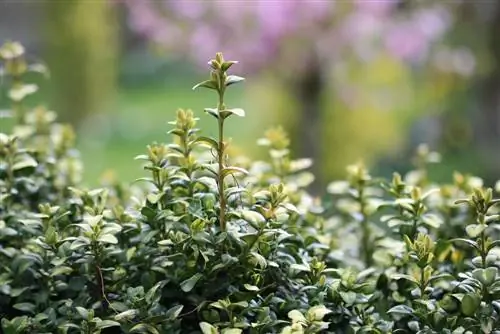
There is a little more going on within the genus, the world plant list currently contains 109 recognized boxwood species, but most of them grow in the tropics, only two in Europe and only one species here, because it is second, the Balearic boxwood, is too cold for us.
For planting in Germany and countries with a similar climate, only the common boxwood Buxus sempervirens remains, and now you know why the boxwoods in your area look very similar: That's because they are very similar are - like all boxwoods throughout the northern hemisphere.
This boxwood has been bred by us for a very long time, but has obviously successfully resisted every attempt at a sensational transformation through breeding, which is why we limited ourselves (had to limit ourselves) to detailed changes: size of the leaves, strength + number of shoots, Dense + horizontal expansion of the growth habit. With regard to the suitability for topiary, these are crucial detail changes that are involved in the fact that the classic topiary trees were and are cut from boxwood.
The smaller and more uniformly oval the leaves and the denser the growth, the easier it is to see the contours of a figure when cutting the plant (just imagine that you should make one out of a trumpet tree with leaves twice the size of your palm cut a detailed shaped figure - it would have to be 200 m high so that the contours come out well). If breeders hadn't offered perfect boxwoods a long time ago, perhaps privets and false cypresses could be seen cut into wild shapes everywhere.
But boxwood trees are the first choice if you want to have a complicated figure in your garden at some point. You can choose whether to select the cultivar according to the pruning plan or to adapt the pruning to the cultivar; The following are the best boxwood varieties for topiary:
- Buxus sempervirens 'Angustifolia': Grows round and wide and is suitable for any simple shape
- Buxus sempervirens 'Blue Heinz': Grows round, very dense and low in all small, rounded shapes
- Buxus sempervirens 'Globosa': Grows densely and reaches the same diameter in every direction, for balls, pompoms and squares
- Buxus sempervirens 'Herrenhausen': Particularly wide growth habit for flat shapes
- Buxus sempervirens 'Hollandia': Dense, almost spherical growth for all rounded shapes
- Buxus sempervirens 'Suffruticosa': Fast, upright growth with strong main branches, the box for narrow conical shapes
- Buxus sempervirens var. arborescens: Natural variant with rounded, conical, dense and not too slow growth, a box for simple figures
Tip:
Caught the wrong variety, is your boxwood growing way too fast? Be happy, the boxwood seems to like the location. If the shape doesn't work, you can simply let the boxwood grow and declare it your house tree. In the past, the boxwood was often chosen as a house tree, especially in rural areas; the branches were used in bunches or wreaths for decorations.



